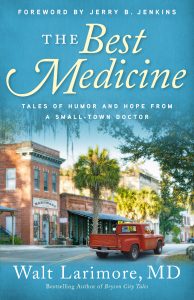
Drinking decaffeinated, ground, or instant coffee significantly reduces new CVD and premature death
October 24, 2022
Exercise boosts brain function in kids with obesity
October 26, 2022For the next few months, I’m excerpting chapters from the first of two books about my early years in family medicine in Kissimmee, Florida – The Best Medicine: Tales of Humor and Hope from a Small-Town Doctor. I hope you, your family, and your friends will follow along and enjoy this trip back into the past with me and my family.
CHAPTER 8A – KATIE
I ran through the double doors leading into the labor and delivery suite.
“Are you Dr. Larimore?” yelled a nurse from the door of one of the two delivery rooms at the far end of the hall.
“Yes!”
“I’m Sandi Lynch. Good to meet you. Now, scrub up quick! One of Dr. Hartman’s patients is about to deliver. What size gloves?”
“Eight,” I said, running up to the scrub sink, which was just outside the delivery rooms. I grabbed two shoe covers, a head cover, and a mask, and quickly put them on. Looking through the window above the sink into the delivery room as I scrubbed my hands and arms as fast as possible, I could see a tall, young woman in the delivery position. Sandi was cleaning her perineum with Betadine antiseptic solution while another nurse was setting up instruments on a side table. A nursery nurse was preparing the baby bassinet and warmer to receive the little one.
To my surprise, the very top of the baby’s head was just visible between the mother’s labia, what we call crowning, as she cried out in pain during a contraction. A stocky, mustached man with a round face and ruddy cheeks, who I presumed was the father of the baby, was at the woman’s side, looking panicked and wearing disposable sterile paper pants, a V-neck shirt cover, surgical mask, and head cover. He looked far out of his comfort zone—as do most men in this situation.
I rinsed my arms, backed through the door into the room, dried off, grabbed and quickly put on a sterile gown, and then donned the surgical gloves. The man looked at me with horror and exclaimed, “Just who the heck are you? You’re not Dr. Hartman! We want our doctor! Now!”
The woman let out another painful moan, pushed, and the baby’s head bulged out even more.
“Well, sir, she’s about to deliver, and I’m the only doctor you have right now! I’m Dr. Hartman’s new partner, Dr. Larimore. What are your names?”
He seemed to calm down a bit. “I’m Victor Lockwood, and this is my wife, Jennifer. This is our first baby.”
“Any problems during pregnancy?” I asked as I began placing the drapes over her legs and abdomen. I could hear the baby’s heartbeat on a fetal monitor. The rate and rhythm were normal. I palpated Jennifer’s tummy and the baby’s head. The position for delivery was perfect.
“No, sir,” Victor answered. “Jennifer and the baby have been healthy as can be. No problems until the membranes ruptured at home.”
“Prenatal record is clean. No issues at all,” said Sandi.
“Vitals?”
“Normal,” Sandi said. “Due date is tomorrow.”
I smiled. “Tomorrow’s my daughter’s birthday. But I don’t think your little one will wait until then.”
Jennifer let out a yelp.
“Okay to push?” Sandi asked.
I nodded, and Sandi had Victor lift Jennifer’s head and instructed her to take a deep breath and then give a prolonged push. As she did, I began to massage the perineum and flex the baby’s head. In maternity care, a midwife’s maxim is that “flexion is your friend.” With a vaginal birth, keeping the head flexed presents a smaller circumference, making delivery easier and reducing the likelihood of a tear or the need for a surgical cut called an episiotomy. Avoiding either would make recovery both more comfortable and faster for Jennifer.
Jennifer took quick short breaths between contractions. “The next one should do it,” I said, trying to sound confident and assured, although my heart was racing. Here I was, a new and untested doctor, at least in this hospital, having to audition in front of new patients, unfamiliar birth attendants, and in a facility using an old-fashioned delivery room and delivery table.
During my medical school days at LSU Charity Hospital in New Orleans and my family medicine residency at Duke, I had been well-trained in these old delivery techniques. But I much preferred the family-friendly birthing suites and midwife techniques we developed in Bryson City—and the professional birth assistants, called doulas, who assisted us.[i] If these nurses had not been exposed to the more modern approach, then I expected my plans for after the delivery would be a shock to them.
Jennifer began to moan. Vic lifted her, and Sandi instructed, “Take a deep breath, then give the doctor a long steady push.”
As she did, without trauma to the perineal tissues, I delivered the baby’s head.
“Jennifer, stop pushing! Pant!” I advised. As she did so, I suctioned the mucus from the baby’s nose and mouth. It was clear—neither bloody, which would have suggested trauma, nor meconium-stained, which would have meant the baby passed stool into the amniotic fluid.
Now came the moment that might shock these traditional labor and delivery nurses but create a lifelong memory for this mom and dad. “Victor,” I said. “I’d like you to lift Jennifer.” She was panting. “Jennifer, I want you to reach down with both your hands and help me deliver your baby.” Her eyes widened a bit. She looked at Victor and then at me.
“Can I?”
I grinned under my mask as I saw Sandi and the other nurses’ eyes enlarge in surprise. Jennifer’s contraction began, and she moaned.
“Okay, let’s go!”
[i] The term doula comes from the ancient Greek word meaning female helper or maidservant. Throughout history, women have traditionally supported a woman through labor and birth. A modern doula is trained (and usually certified) to provide continuous physical, emotional, and informational support to a mother before, during, and shortly after childbirth to help her achieve the healthiest, most satisfying experience possible. Many scientific studies examining doula care demonstrate remarkably improved physical and psychological outcomes for both mother and baby (see www.DONA.org for more information).
This excerpt from The Best Medicine: Tales of Humor and Hope from a Small-Town Doctor is provided with the permission of the publisher Baker/Revell. You can learn more about the book or purchase a copy here.
© Copyright WLL, INC. 2022.




